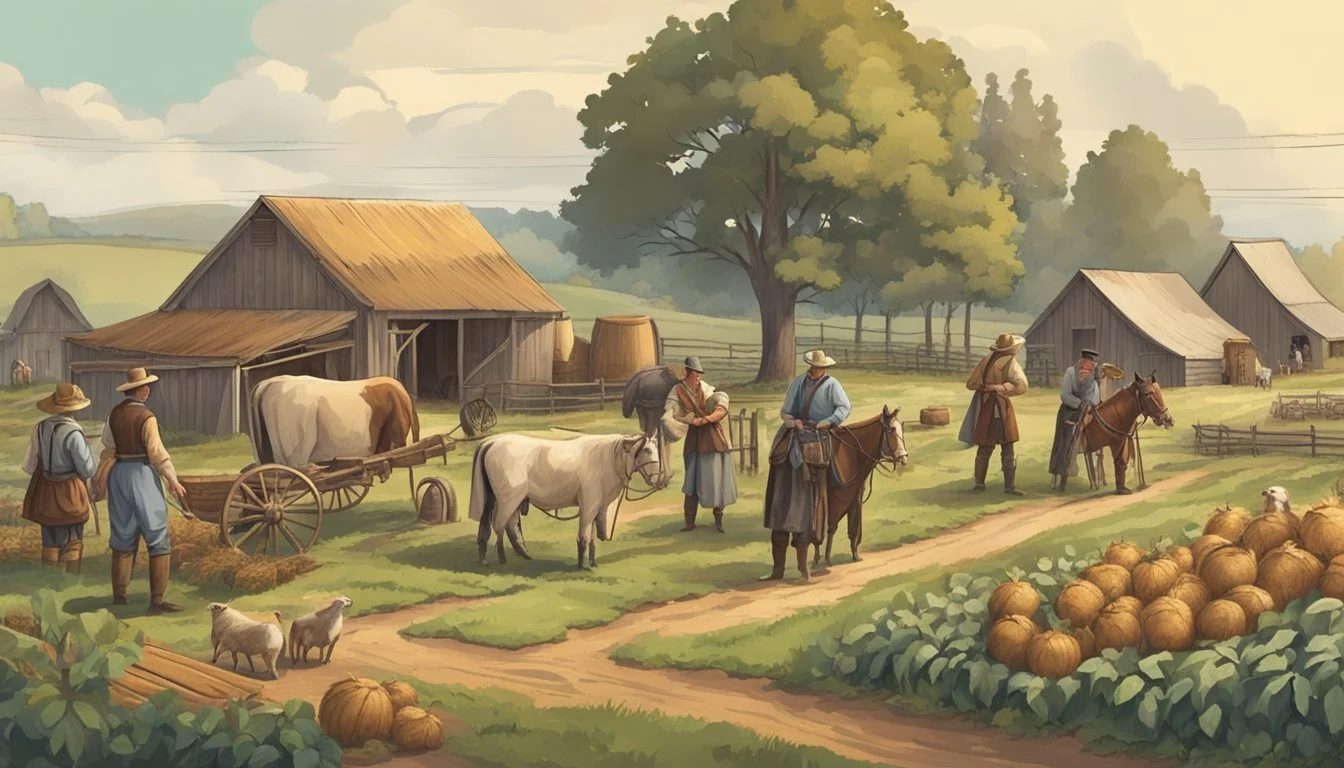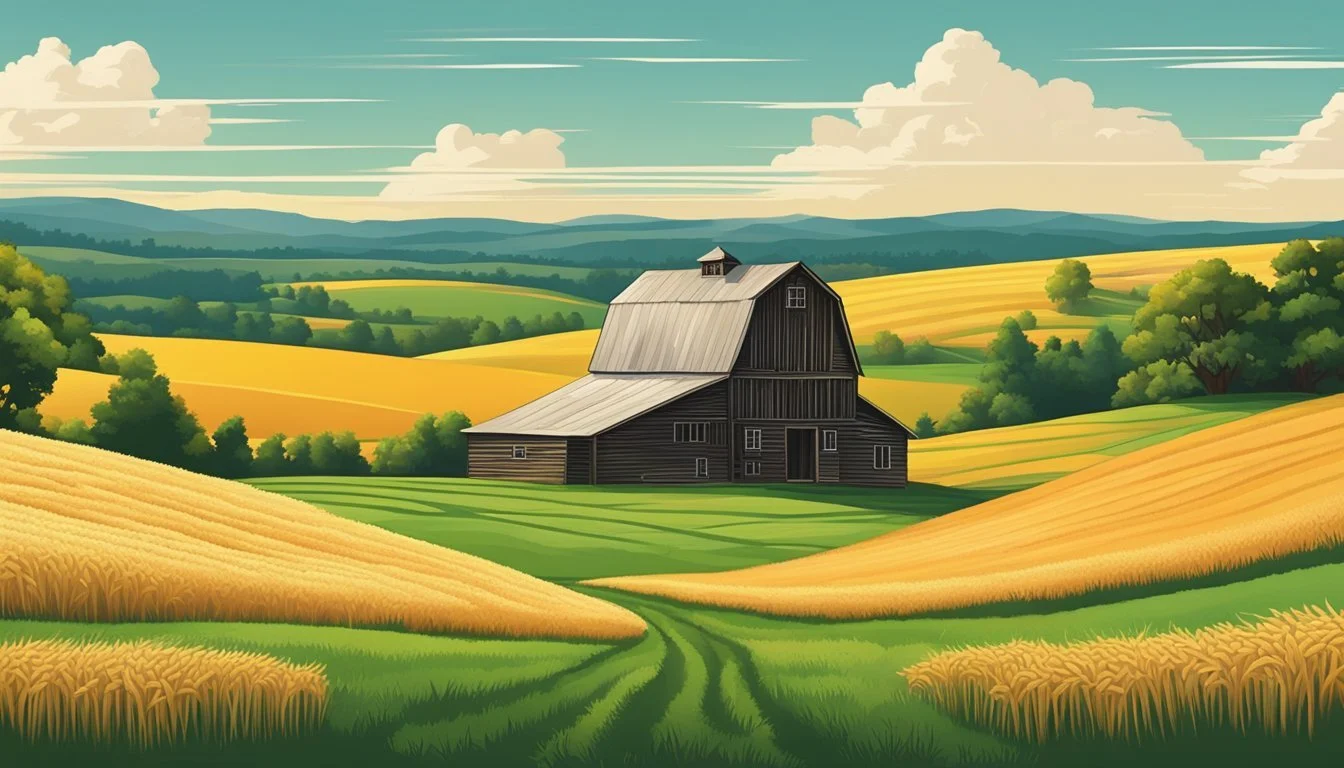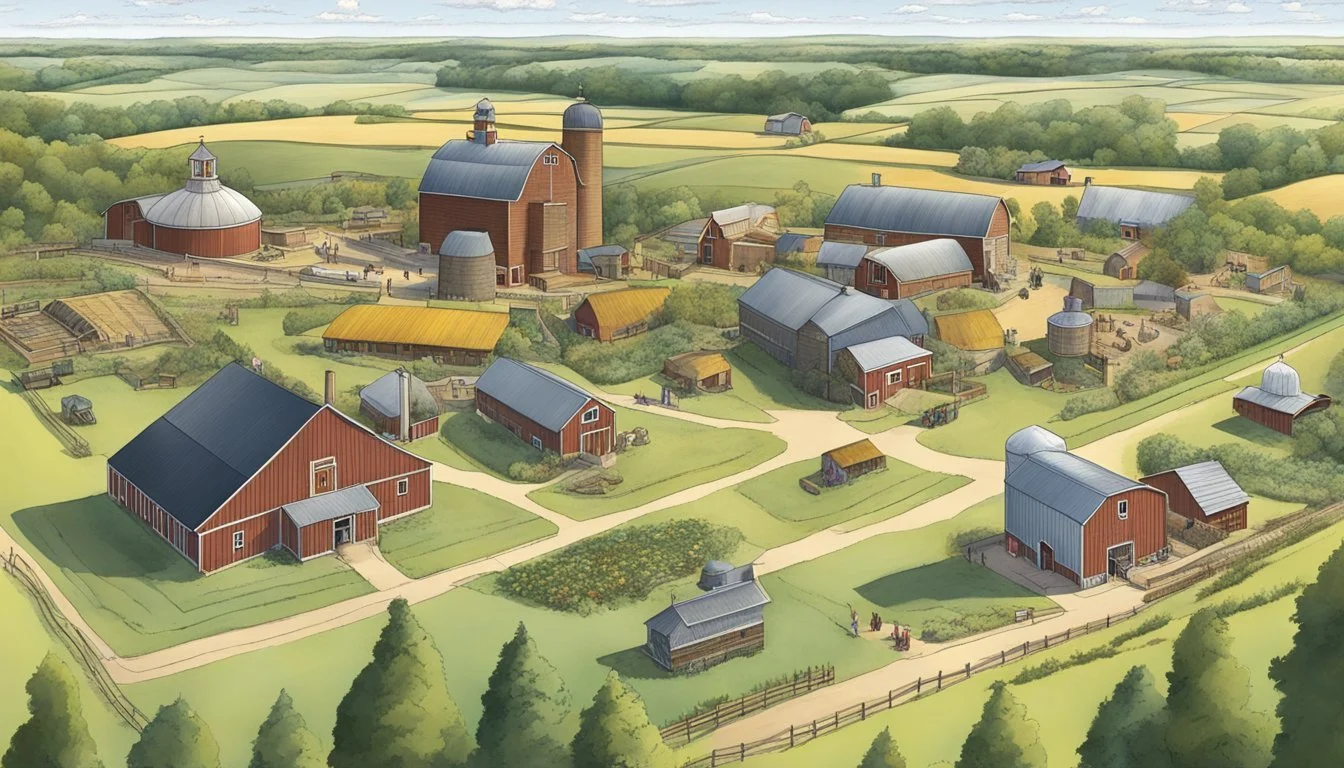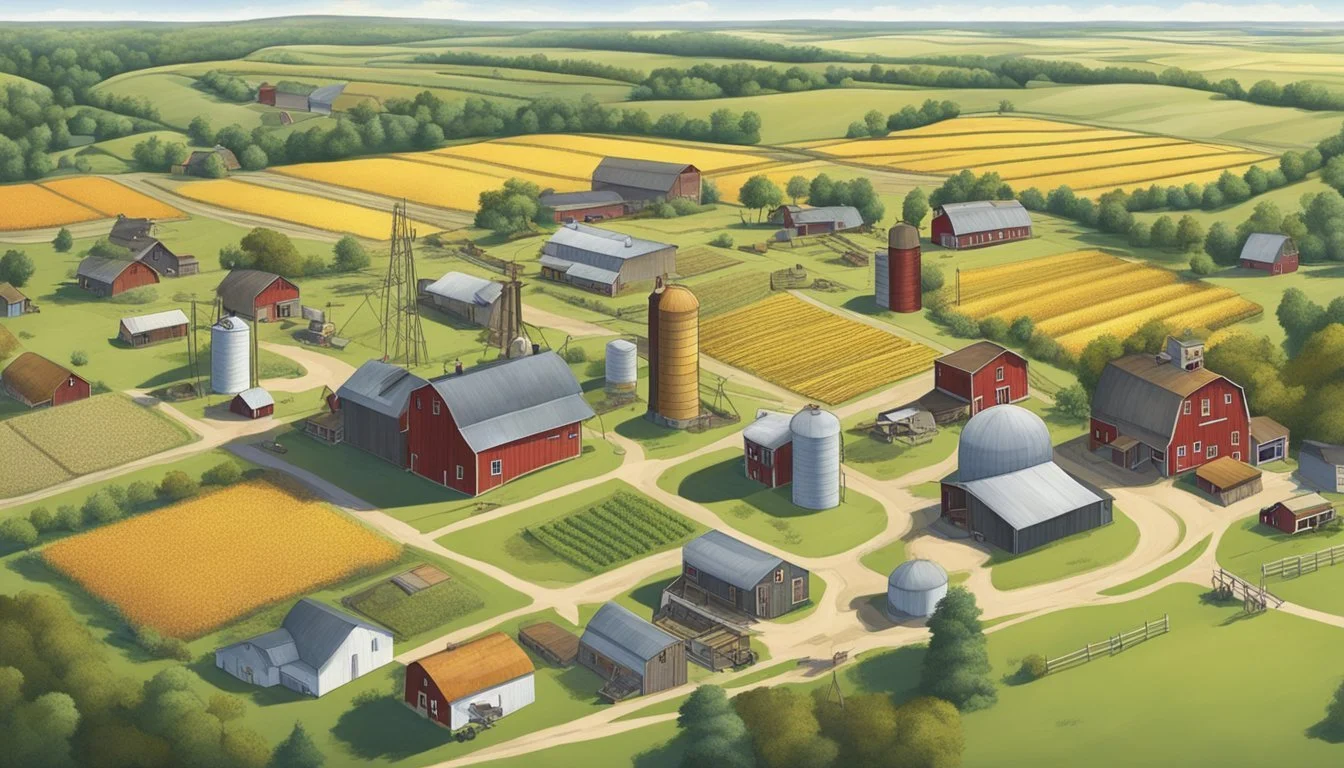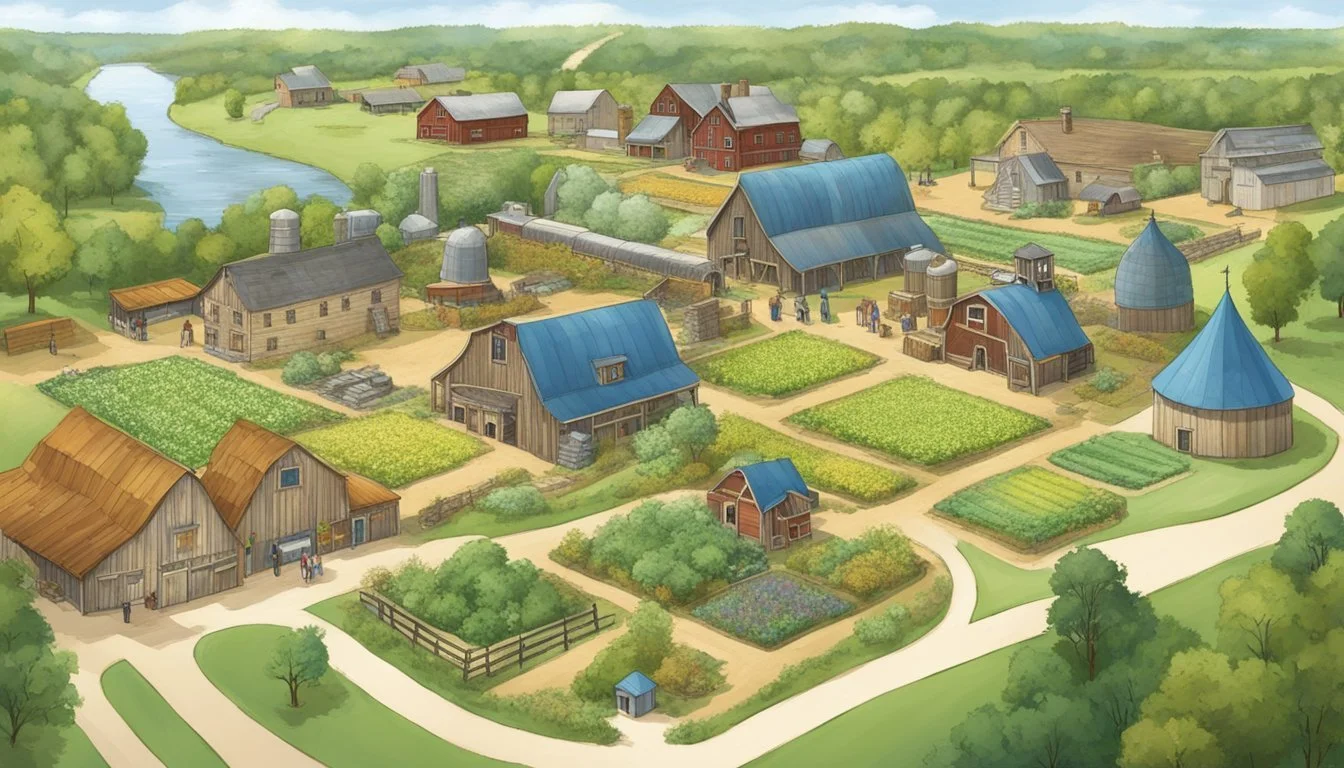Historical Farms and Agricultural Museums in Minnesota
A Guide to Rustic Heritage Sites
Minnesota's rich agricultural history is preserved and celebrated in its numerous historical farms and agricultural museums. These institutions serve as both educational resources and windows into the past, allowing visitors to step back in time to understand the state's farming heritage. With a landscape that ranges from the rolling prairies of the south to the rugged, forested north, Minnesota's diverse geography has shaped its farming practices and communities over the centuries.
Historical farms across the state, such as the Oliver Kelley Farm, offer a living history experience, providing insight into the evolution of agriculture from the 19th century to the present. As a significant figure in Minnesota's farming history, Oliver Kelley founded the Order of the Patrons of Husbandry, also known as the Grange movement, which advocated for agricultural education and community. His farm is now a testament to these early agricultural advancements.
Meanwhile, agricultural museums in Minnesota not only showcase vintage farming equipment and techniques but also highlight the importance of agriculture to the state's development. Places like the Minnesota History Center feature exhibits that delve into the personal stories of Minnesotan farmers, as well as the broader societal impact of agriculture. These venues foster a deeper appreciation of the toil and innovation that have driven Minnesota's agricultural success.
History of Agricultural Development in Minnesota
Minnesota's agricultural sector has experienced significant transformation from indigenous farming practices to the innovations of European settler agriculture and the impactful Grange Movement. Rich with history, Minnesota's land has been pivotal to farming and agriculture, positioning it as an essential part of the Midwest's and United States' agricultural evolution since the 1860s.
Indigenous Farming Practices
Before European settlers arrived, indigenous peoples in what is now known as Minnesota practiced sophisticated farming methods. They cultivated the land, growing crops like maize while also implementing techniques for soil enhancement and crop rotation. Their sustainable approaches maintained soil fertility and supported their communities.
European Settler Agriculture
With the arrival of European settlers in the 19th century, Minnesota's agricultural landscape saw radical changes. The settlers introduced new farming tools and crops, dramatically increasing the scale and output of farming activities. By the 1866 State Fair in Rochester, Minnesota's agriculture began adopting more structured societies like the Minnesota State Horticultural Society, which focused on sharing knowledge and further developing the agricultural industry.
The Grange Movement and Cooperative Extension
The Grange Movement, initiated in the 1860s, played a key role in Minnesota's farming evolution. It sought to empower farmers through education and collective action, leading to the establishment of the cooperative extension service. This initiative enhanced agricultural practices by introducing scientific farming methods and fostering a sense of community among farmers. Moreover, it was instrumental in the promotion of farmer rights and interests during the critical development phase of Minnesota's agriculture.
Key Historical Farms in Minnesota
Minnesota's rich agricultural heritage is embodied in key historical farms and agricultural museums that tell the story of the state's development in farming. These locations not only preserve the past but also educate on the evolution of agricultural techniques and the pioneers behind them.
Oliver Kelley Farm
Oliver Kelley, one of the founders of the Grange movement that revolutionized American farming, established his farmstead in 1850. This working historical farm provides insights into 19th-century farming practices. Visitors can learn about the importance of crop rotation and livestock in maintaining a successful farm.
Key Points About Oliver Kelley Farm:
Location: Elk River, Minnesota
Founded: 1850
Notable Contributions: Birthplace of the Grange movement
Wendelin Grimm Farmstead
The Wendelin Grimm Farmstead holds significance due to Wendelin Grimm's pioneering work with alfalfa. Grimm's perseverance in cultivating a winter-hardy alfalfa variety in the 1850s led to a revolution in dairy and cattle farming, making it a key crop in Minnesota's agricultural history.
Key Points About Wendelin Grimm Farmstead:
Location: Carver County, Minnesota
Famous for: Developing winter-hardy alfalfa
Impact: Transformed dairy and cattle farming
Faribault House
The Faribault House stands as a testament to the agricultural pursuits of Alexander Faribault, involved in early Minnesota farming practices in the 1800s. Faribault House showcases the period's farm techniques and introduces visitors to the cultivation of essential crops like corn.
Key Points About Faribault House:
Location: Rice County, Minnesota
Established: 1853
Focus: Early Minnesotan crop cultivation methods
Living History Farms and Reenactments
Living history farms in Minnesota offer visitors the unique opportunity to experience rural life as it was in the past, complete with authentic activities, animals, and gardens. These sites provide interactive experiences that combine historical education with entertainment through reenactments and events that encapsulate the pioneer spirit.
1860s Living History Events
Events set in the 1860s provide an immersive experience into agricultural life of the time. Visitors can observe and sometimes participate in traditional farming activities, watch reenactors demonstrate period-specific techniques, and interact with various breeds of heritage animals. The well-tended gardens showcase heirloom plant varieties that would have been common in the era, offering an educational glimpse into the horticulture practices of the past.
Little House on the Prairie Sites
Minnesota is also known for its "Little House on the Prairie" sites, which bring Laura Ingalls Wilder's beloved stories to life. Guests can walk through reconstructed cabins and buildings that replicate the Wilder family's 19th-century homestead. Interactive activities often include craft demonstrations, cooking with recipes from the time, and horse-drawn wagon rides, allowing visitors of all ages to connect with the pioneering days of the American Midwest.
Agricultural Museums and Collections
Minnesota's rich agricultural heritage is showcased across various sites and collections, with institutions like the Minnesota Historical Society playing a pivotal role. These settings offer in-depth insights into the state's farming past, grain trade evolution, and the cultural impact of agriculture.
Mill City Museum
The Mill City Museum, located on the historic Mississippi riverfront, delves into the intertwined stories of the flour industry, the river, and the city of Minneapolis. It is here that one can explore the once-largest flour mill in the world, the Washburn A Mill, and understand how Minneapolis became a global leader in flour production.
Minnesota Historical Society History Center
At the Minnesota Historical Society History Center, one can find a wealth of information on the state's agricultural progress. The society curates a vast array of collections that detail the history of farming life and technological advancements in agriculture. Significant exhibits discuss the Rice and Washington counties' contributions to Minnesota's agricultural landscape, reflecting the regional diversities within the state's farming community.
Hjemkomst Center
The Hjemkomst Center, situated in Moorhead, offers a unique view of agricultural history through its Scandinavian heritage focus. The center not only showcases a full-scale replica of the Viking ship Hjemkomst but also presents exhibitions on the agricultural practices of the Nordic immigrants who settled in Minnesota, influencing the region's farming techniques.
Preservation and Education Initiatives
Preservation and education in Minnesota are paramount in maintaining the rich heritage of agricultural practices and rural life. These initiatives are crucial for imparting knowledge to current and future generations about the historical significance and evolution of farming and agriculture.
Minnesota Landscape Arboretum
The Minnesota Landscape Arboretum plays a significant role in preserving diverse plant species and offering educational opportunities. Its mission is to cultivate an understanding of plant life and its importance to our world through research, conservation, and education. Guests can explore a variety of natural and cultivated landscapes, gaining insight into the interplay between agriculture and ecology.
Association for Living History, Farm and Agricultural Museums
The Association for Living History, Farm and Agricultural Museums (ALHFAM) actively supports those involved in living historical farms, agricultural museums, and outdoor museums of history and folklife. Their work emphasizes interactive education through living history methods, creating immersive experiences that convey the workings of historical farms to the public.
National Park Service and USDA Partnerships
Partnerships between the National Park Service and the U.S. Department of Agriculture exemplify the collaboration needed to safeguard America's pastoral narratives. These partnerships often result in programs that combine resources to protect historically significant landscapes and offer educational programs, thereby promoting a deeper appreciation of the nation's agricultural history.
Cultural and Natural Heritage Conservation
Historical farms and agricultural museums in Minnesota are dedicated to preserving both the cultural aspects of farming and the natural diversity of the region. These sites often feature a blend of heritage crop varieties and native plants and wildlife, underscoring the importance of conserving agricultural traditions alongside natural ecosystems.
Heritage Crops and Seeds
Historical farms in Minnesota take conservation seriously by maintaining collections of heritage crop varieties and seeds. These are pivotal not merely as genetic resources but also serve as living histories of agriculture in the state. At places like the Oliver H. Kelley Farm, visitors can find an array of heirloom vegetables grown in gardens that mirror those from the 19th century, thus conserving the genetic diversity integral to Minnesota's agricultural legacy.
Oliver H. Kelley Farm
Heirloom Vegetables
19th Century Garden Layout
Seed Preservation Programs
Wildlife and Native Plants Conservation
Conservation efforts extend beyond crops to include wildlife and native plants. Nature trails wind through many of these historical sites, offering opportunities to engage with the natural habitats that thrive alongside cultivated areas. These trails often lead to special conservation gardens or natural zones designed to support local ecosystems. Wildlife conservation is a key aspect, with efforts in place to protect habitat and maintain biodiversity.
Nature Trails & Conservation Efforts
Habitats for Birds and Pollinators
Native Plant Gardens
Educational Programs on Ecosystems
By integrating these elements, Minnesota's historical farms and agricultural museums offer a comprehensive view of cultural and natural heritage conservation, ensuring these traditions and ecosystems are available for future generations to appreciate and learn from.
Modern Agriculture and Research
Minnesota's agricultural landscape is shaped by cutting-edge advancements and a dedication to research that propels farming into the future.
Contemporary Farming Technologies
In Minnesota, modern agriculture leverages technology to enhance crop productivity and resource management. Precision agriculture uses GPS mapping and data analytics to inform decisions on planting, harvesting, and soil management. Drones and satellites provide aerial data, while robotics and automated machinery streamline operations.
GPS Technology: Ensures efficient field navigation and resource distribution.
Drones: Aid in crop monitoring and health assessment from above.
Agricultural Research Institutes
The state is home to several institutions focused on agricultural innovation. The University of Minnesota is key, with its research complex in Mower County at the forefront of initiatives. They concentrate on sustainable food production and support Minnesota's $112 billion annual agricultural economy.
Focus Areas:
Sustainable crop management
Livestock health and productivity
Development of new oat varieties
Hog farming practices
Research Institutes such as the Minnesota Agricultural Experiment Station (MAES) have made significant strides in areas specifically related to oats and livestock, fostering advancements that shore up Minnesota's position in modern farming and agricultural sustainability.
Economic Impact and Rural Communities
Minnesota's agricultural sector has a substantial impact on its economy, particularly in rural communities where agriculture serves as a key economic driver. This impact is multifaceted, reflecting both direct effects on the local economy and indirect support through various initiatives.
Farmers' Markets and Local Product Sales
Farmers' markets play a pivotal role in Minnesota's rural economies. By selling locally grown products, these markets bolster the local economy and create jobs within the community. Sales of fresh produce, meats, and artisanal goods at farmers' markets not only generate income for local farmers but also encourage the circulation of money within rural areas.
For example, the Economic Impact of Museums in Minnesota report highlights the value institutions like agricultural museums bring to state and local economies by promoting farmers' markets and the sale of local products.
Agricultural Grants and Economic Support
Grants and economic support programs are integral to sustaining Minnesota's rural communities. These grants provide necessary financial assistance to farmers and agricultural businesses, helping to innovate their operations and become more competitive in the market.
The availability of agricultural grants fosters economic growth by incentivizing the development of farming techniques and the production of high-quality local products. For example, economic analyses, such as the one on the contribution of Minnesota agriculture, detail how economic support contributes to keeping family farms operational and maintaining jobs in rural areas.
Visitor Experience and Amenities
Visitors to historical farms and agricultural museums in Minnesota can expect a robust offering of amenities and activities that cater to a variety of interests, from educational programming to seasonal events. These sites provide unique opportunities to explore agricultural history through immersive experiences.
Seasonal Events and Festivals
The Oliver Kelley Farm, an integral part of the Minnesota Historical Society, hosts a range of seasonal events that engage visitors with the traditions of 19th-century farming. With events that communicate the historical significance of agriculture, visitors can enjoy transformative experiences, including spring planting, harvest festivals, and holiday-themed gatherings that reflect the farm's commitment to preserving and interpreting rural life.
Museum Shops and Souvenirs
Most historical farms, including the Oliver Kelley Farm, feature a museum shop where guests can purchase keepsakes that reflect the agricultural heritage of the region. Products range from educational books and unique toys to handcrafted items that embody the spirit of Minnesota farming. The shops support these institutions by offering products directly related to the farm's history and the visitors' experiences, making it a perfect stop to find a token of remembrance.
The amenities and activities offered at such locations are dedicated to enhancing the visitor's understanding and appreciation of Minnesota's rich farming past.
Supporting Organizations and Networks
Several organizations provide backing and a network for historical farms and agricultural museums in Minnesota. These bodies are vital in presenting the agricultural history of the region, offering both expertise and resources to ensure this heritage remains vivid and accessible.
Minnesota Farm Bureau
The Minnesota Farm Bureau stands as a cornerstone organization supporting the state's agricultural heritage. It operates with a robust membership base, comprising farmers and those interested in farming practices, with a focus on education and advocacy. They engage with historical farm museums in Minnesota to ensure that the narrative of the state's farming history is accurately shared and preserved.
Farmers Union and Advocacy Groups
Farmers unions, specifically in Minnesota, are dedicated to protecting the interests of farmers and rural communities. These advocacy groups work closely with historical agricultural museums to aid in conveying the story of farming and its evolution. Through a combination of education, cooperation, and legislation, these unions ensure that the farming legacy remains a crucial part of the community discourse. They offer a link to the living history that organizations like the Association for Living History, Farm and Agricultural Museums (ALHFAM) emphasize in their mission.
Additional Resources and Archives
The rich tapestry of Minnesota's agricultural past is preserved in the vast collections of the Minnesota Historical Society. Researchers and history enthusiasts alike can access manuscripts, microfilm, photographs, and indexes detailing the legacy of the state's farmsteads.
Manuscript and Microfilm Collections
The Gale Family Library offers an extensive range of manuscript collections that provide in-depth insights into the personal, economic, and social aspects of Minnesota farms. These collections include personal papers, business records, and other primary sources that are available on microfilm for ease of access and preservation. Specifically, the library's Farm/Building Records provide valuable information for anyone researching family farms across the state.
Photographic Archives and Exhibits
A picture can convey a thousand words about the history of farming. The Minnesota Historical Society houses a significant collection of photographs that breathe life into the agricultural stories of yesteryears. These images are not only preserved in archives but also become part of exhibits within the Minnesota History Center, allowing the public to visually experience the evolution of farming practices in Minnesota.


